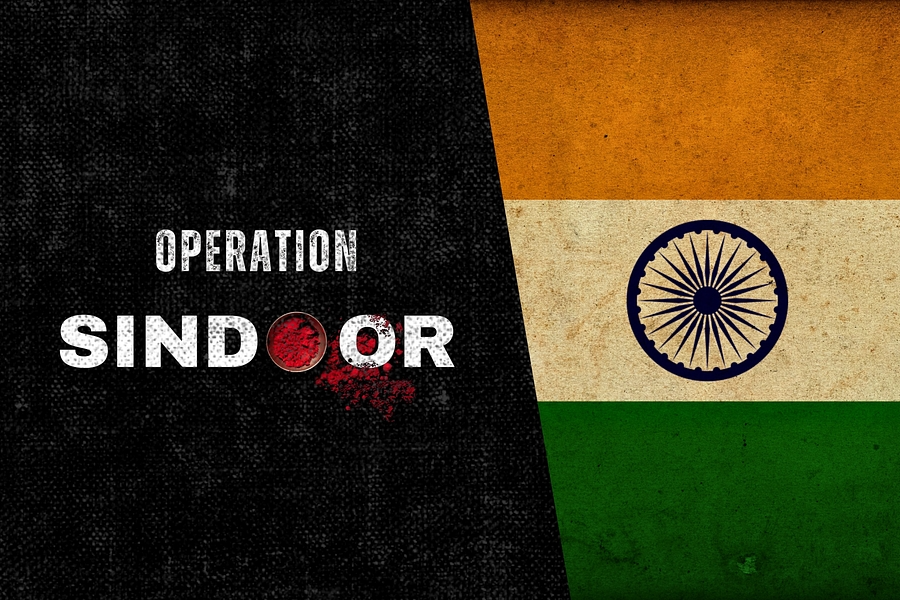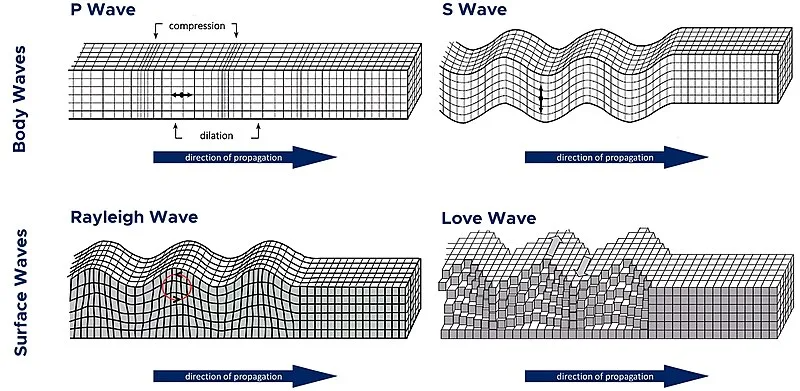September 22nd Current Affairs
Table of Contents
Kannada Literature Optional Syllabus
Home / ಐಚ್ಚಿಕ ಕನ್ನಡ ಸಾಹಿತ್ಯದ ಪಠ್ಯಕ್ರಮ ಐಚ್ಚಿಕ ಕನ್ನಡ ಸಾಹಿತ್ಯ ಪತ್ರಿಕೆ – 1 ವಿಭಾಗ – ಎ ಅ) ಕನ್ನಡ ಭಾಷೆಯ ಚರಿತ್ರೆ ಭಾಷೆ
UPSC Current Affairs – October 6th
October 06th Current Affairs Home / Table of Contents 36-hour curfew imposed in parts of Odisha’s Cuttack over communal tensions
Religious Minorities in India and the Challenge of Communal Harmony: A Sociological Reflection on the Cuttack Violence
Home / Religious Minorities in India and the Challenge of Communal Harmony: A Sociological Reflection on the Cuttack Violence Sociology
UPSC Current Affairs – October 4th
October 04th Current Affairs Home / Table of Contents Isabgol Processors threaten to halt purchases from October 6th over GST
Sologamy and Contemporary Trends in Marriage: A Sociological Perspective
Home / Sologamy and Contemporary Trends in Marriage: A Sociological Perspective Sociology Paper 1: Systems of Kinship – Contemporary trends
UPSC Current Affairs – October 3rd
October 03rd Current Affairs Home / Table of Contents NASA IMAP to show how solar particles are energised and shield
Understanding Indian Festivals through Durkheim: Religion, Rituals, and Collective Conscience
Home / Understanding Indian Festivals through Durkheim: Religion, Rituals, and Collective Conscience Sociology Paper 1: Émile Durkheim – Religion and
UPSC Current Affairs – September 30th
September 30th Current Affairs Home / Table of Contents Ladakh groups reject talks with government, Ministry says open to dialogue
Caste Census in India: A Sociological Perspective
Home / Caste Census in India: A Sociological Perspective Sociology Paper 2: Caste System – Features of Caste system. The
Constitutional Morality: Upholding India’s Democratic Ethos
Home / Constitutional Morality: Upholding India’s Democratic Ethos Sociology Paper 2: Visions of Social Change in India – Constitution, law,
PM Modi pitches for 'swadeshi' goods, says GST reforms will accelerate India's growth story
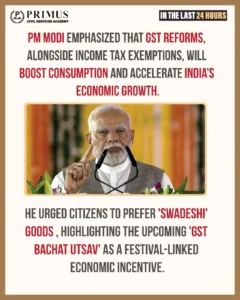
Relevance to UPSC
- Paper II: Polity, Governance and Economic Governance
The GST reforms, “one nation one tax,” tax rate rationalisation, role of GST Council etc. fall under governance, fiscal federalism, tax policy, and implementation. - Paper III: Economy
Because GST is a major fiscal instrument, this involves indirect taxation, effects on revenue, ease of doing business, cost inflation, consumer welfare, MSMEs etc.
More About the News
- Prime Minister Narendra Modi said that with the coming-into-effect of “next generation” GST reforms from 22 September (Navratri), India has realised the “one nation one tax” dream, reducing the number of GST slabs and lowering rates on many goods.
- The reforms include a “GST Bachat Utsav” (savings festival) aimed at consumers, plus income tax exemptions (up to ₹12 lakh), jointly forming a “Double Bonanza” especially for poor, middle, neo-middle class, women, farmers and traders.
- Reduced tax rates will apply to about 375 items, including many mass consumption goods, e.g. kitchen staples, electronics, etc, with a simplified two-tier structure for most goods/services (5% & 18%), while ultra-luxury and sin/demerit goods remain at higher rates.
Swadeshi Movement
The Swadeshi Movement (1905–1911) emerged as a mass nationalist movement in India in response to the Partition of Bengal (1905) by the British. It sought to promote indigenous industries, boycott foreign goods, and foster economic self-reliance as a means to assert political freedom and cultural identity. The movement laid the foundation for organized mass resistance and modern Indian nationalism.
Background
- Triggered by the Partition of Bengal (1905) by Lord Curzon, seen as a “divide and rule” policy.
- Emergence of economic nationalism to counter British economic exploitation.
- Rise of political consciousness among educated Indians, students, and merchants.
Evolution
- Initial phase (1905–1908): Focused on boycott of British goods and promotion of Indian-made products.
- Moderate phase: Limited political mobilization, petitions, and resolutions in Congress.
- Extremist phase: Leaders like Bal Gangadhar Tilak pushed for active protests, strikes, and national education institutions.
- Decline: Post-1911, after annulment of Bengal partition, movement gradually declined but left lasting nationalist sentiment.
Inspirations Drawn From
- Economic nationalism: Protecting indigenous industries like textiles.
- Cultural revivalism: Reviving Indian crafts and traditional skills.
- Global anti-colonial movements: Early 20th-century global resistance to imperialism inspired mass mobilization.
- Moral and ethical persuasion: Gandhian thought later built on Swadeshi ideals of self-reliance and non-violence.
Popular Leaders
- Bal Gangadhar Tilak – Extremist leader promoting assertive action.
- Bipin Chandra Pal – Advocated boycott of foreign goods and mass mobilization.
- Lala Lajpat Rai – Promoted economic and political nationalism.
- Aurobindo Ghosh – Played role in revolutionary aspects of Swadeshi movement.
- Rabindranath Tagore – Cultural revival, popularized national songs, literature.
Features of the Movement
- Boycott of foreign goods (textiles, British products).
- Promotion of indigenous industries and khadi production.
- National education initiatives: Establishment of national schools and colleges.
- Mass mobilization: Involvement of students, women, traders, and workers.
- Use of symbols: Songs, slogans, pamphlets to spread nationalism.
Key Events
- 1905: Partition of Bengal triggers the movement.
- 1905–1906: Formation of Indian National Congress committees promoting Swadeshi.
- 1906: Establishment of national schools like Bengal National College.
- 1907: Extremists vs. Moderates debate in Congress.
- 1911: Annulment of Bengal partition, movement loses momentum but leaves lasting legacy.
Impact of the Movement
- Economic Revival: Boosted indigenous industries; textile industry revived in Bengal through boycott of Manchester goods.
- Political Awareness: Educated masses began questioning British policies; mass protests became common.
- Social Mobilization: Women and students actively participated, women led spinning khadi drives.
- Cultural Nationalism: Revival of Indian arts, literature, and songs; Tagore’s nationalist compositions became popular.
- Institution Building: National schools, colleges, and banks were established like Bengal National College (1906).
Role in Gaining India’s Independence
Mass Political Mobilization – showed power of collective resistance (e.g., boycott campaigns in Bengal)
Fostering National Unity – encouraged cross-class collaboration (merchants, students, workers)
Economic Self-Reliance – laid groundwork for Gandhian Swadeshi movement during Non-Cooperation Movement
Political Training Ground – created leaders like Tilak and Lajpat Rai
Challenging British Authority – showed mass civil disobedience could threaten colonial economic interests
Challenges Faced
- British Repression: Arrests and suppression of extremist leaders like Lala Lajpat Rai.
- Class Differences: Limited participation from rural poor initially.
- Internal Divisions: Extremists vs Moderates in Congress led to fragmentation of efforts.
- Economic Constraints: Indian industries lacked capacity to fully replace British imports.
- Limited Geographic Reach: Mainly confined to Bengal, Punjab, and Maharashtra.
Learnings from the Movement
- Power of Economic Nationalism: Economic self-reliance strengthens political struggle.
- Mass Participation Matters: Effective movements need involvement of all social classes.
- Cultural Identity as Tool: Arts, education, and symbols can galvanize support.
- Leadership is Critical: Charismatic and visionary leaders can sustain momentum.
- Strategic Planning: Coordinated boycott and institution-building is more effective than spontaneous protest.
Impact / Influence on Governance & Policies Post-Independence
Emphasis on industrial self-reliance – promotion of khadi and small-scale industries
Formation of cooperative and public sector institutions to reduce foreign dependence
Policies promoting indigenous education and culture – e.g., NCERT curriculum integrating nationalist thought
Early frameworks for consumer protection and local enterprise promotion
Influence on economic planning – Five-Year Plans emphasizing self-sufficiency and rural development
The Swadeshi Movement demonstrated that true freedom encompasses economic, cultural, and political dimensions. It taught that self-reliance and collective action can challenge entrenched powers. Its legacy reminds us that the pursuit of national identity and social justice are inseparable from the struggle for independence.
Prelims MCQ
Q. Consider the following statements about the Swadeshi Movement: 1. It was launched primarily in response to the Partition of Bengal in 1905. 2. The movement encouraged the boycott of foreign goods and revival of indigenous industries. 3. It was a purely non-political, cultural movement with no economic or political objectives. Which of the above statements is/are correct?
A. 1 only
B. 1 and 2 only
C. 2 and 3 only
D. 1, 2 and 3 only
Mains Question
Q. Critically examine how the Swadeshi Movement laid the foundation for economic nationalism in India and its role in shaping post-independence policies of self-reliance. Illustrate your answer with examples.
In post-Sindoor push, 1st batch of BSF ‘drone commandos’ soon

Relevance to UPSC
Paper III: Internal Security, Science and Technology
- The initiative reflects modernisation of border guarding forces, counter-drone capability, use of unmanned aerial systems (UAS) in surveillance/offensive roles, which is directly relevant under internal and border security.
- Indigenous development of drone tech, collaborations with IITs, R&D labs, stealth/noiseless drones etc. fall under technology in security, innovation in defence.
More About the News
- The BSF’s Tekanpur training institute in Madhya Pradesh is launching its first batch of “Drone Commandos” (about 47 personnel) under its newly formed Drone Warfare School, which splits its focus into two courses, one for Personnel (drone commandos) and another for Senior Officers (drone warriors).
- The purpose of training includes piloting drones, combat and defensive/offensive tactics, counter-drone operations, surveillance, and even bomb dropping. The school also has wings for R&D and tactics.
- After “Operation Sindoor” and in view of conflicts such as Russia-Ukraine war, BSF is accelerating adoption of drones as standard weapons at battalion level; also collaborating with institutions like IIT-Delhi & IIT-Kanpur for indigenous drone development.
Border Security Force (BSF)
The Border Security Force (BSF), established in 1965, is India’s primary border guarding force tasked with securing international borders and maintaining internal security. Over decades, it has evolved into a technologically equipped paramilitary force, playing a key role in countering infiltration, smuggling, and cross-border threats while maintaining national sovereignty.
Background
- Raised on 1 December 1965, following the Indo-Pak war of 1965, to strengthen border security.
- Initial role: Prevent infiltration and provide armed support to the army along sensitive borders.
- BSF became India’s first line of defense along Pakistan and Bangladesh borders, later extended to China, Nepal, and Myanmar borders.
Evolution
- 1965–1971: Basic border guarding and support to the army.
- 1971: Key role in Bangladesh Liberation War; enhanced operational experience.
- 1980s–1990s: Expansion of border infrastructure and modern surveillance equipment.
- 2000s–present: Integration of UAVs, drones, and modern technology for intelligence and surveillance.
Statutory Provisions
- Established under BSF Act, 1968.
- Functions and powers defined by the Ministry of Home Affairs (MHA).
- Has powers of arrest and investigation along the borders under Criminal Procedure Code (CrPC) for border-related offenses.
Roles & Functions
- Border guarding: Along India-Pakistan, India-Bangladesh borders.
- Counter-infiltration operations: Prevent illegal migration, terrorism, and smuggling.
- Internal security: Deployed during riots, elections, or insurgencies (e.g., Assam, Jammu & Kashmir).
- Anti-narcotics operations: Prevent cross-border drug trafficking.
- Disaster relief & humanitarian assistance: Provides aid during floods, earthquakes, and pandemics.
Jurisdiction Limits
- Limited to international borders and designated border areas.
- Can operate inside the country only under Ministry of Home Affairs directives for internal security operations.
- Cannot function beyond India’s territorial boundaries without government approval.
Advantages of Having BSF
Sovereignty protection – prevents infiltration along Pakistan and Bangladesh borders (e.g., intercepting militants)
Counter-smuggling – curtails illegal arms and narcotics (e.g., anti-drug operations in Punjab)
Disaster response – assists in flood relief in Assam and Bihar
Support to Army – provides strategic depth along borders during wars (e.g., 1971 Bangladesh war)
Community engagement – works with border communities for awareness and welfare program
Impact of BSF
- Enhanced national security: Reduces cross-border infiltration and terrorism incidents.
- Improved law enforcement: Curtails smuggling and illegal migration.
- Disaster mitigation: Quick response during natural calamities will save lives.
- Border infrastructure development: Roads, fences, and outposts in remote areas improve connectivity.
- International perception: Shows India’s proactive stance in securing borders, e.g., during the Doklam standoff.
Issues / Challenges Faced
- Infiltration & terrorist threats: Persistent challenge along Punjab, J&K, and Bangladesh borders.
- Technological gaps: Need for upgraded UAVs and night surveillance equipment.
- Harsh terrain & weather: Operations in deserts, mountains, and rivers are physically demanding.
- Border management coordination: Overlaps with Army, ITBP, SSB lead to jurisdiction issues.
- Personnel stress & casualties: High attrition due to continuous border duty; e.g., 2020 BSF casualties in Kashmir.
Recommendations
Padmanabhan Committee (2005):
- Recommended better border fencing, modern surveillance tech, and integration with local police.
- Enhanced training for counter-insurgency and intelligence-based operations.
- Strengthening morale and welfare measures for personnel.
Government Measures:
- Modernization of border infrastructure: smart fencing, sensors, and night-vision cameras.
- Introduction of drone commandos and UAV surveillance units.
- Welfare initiatives: better pay, housing, insurance, and family support schemes.
- Collaboration with neighboring countries for joint border management and intelligence sharing.
Way Forward
- Integration of AI-based surveillance and real-time data analytics.
- Greater emphasis on community policing along borders.
- Regular joint exercises with armed forces and paramilitary units.
- Enhanced training & career development for better morale and retention.
- Policy reforms to clarify jurisdiction overlaps and improve accountability.
The BSF remains a cornerstone of India’s border security architecture. With evolving threats such as cyber infiltration and drone attacks, modernization and strategic intelligence will define its future. Its effectiveness will depend on balancing technology, human skill, and proactive policy-making to safeguard national sovereignty.
Prelims MCQ
Q. Consider the following statements regarding the Border Security Force (BSF): 1. It was raised in 1965 following the Indo-Pak war. 2. BSF operates under the Ministry of Defence. 3. It has powers to enforce law inside the country only under MHA directives. Which of the statements is/are correct?
A. 1 and 2 only
B. 1 and 3 only
C. 2 and 3 only
D. 1, 2 and 3
Mains Question
Q. Critically examine the role of the Border Security Force (BSF) in India’s national security architecture. Discuss the challenges it faces and suggest measures to enhance its effectiveness in the context of emerging cross-border threats.
Former Karnataka CM Sadananda Gowda loses Rs 3 lakh to cybercriminals
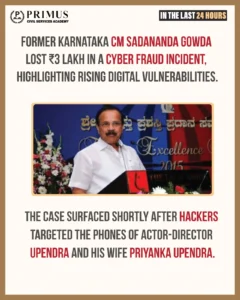
Relevance to UPSC
Paper III: Internal Security, Cyber Security & Science & Technology
- This incident illustrates vulnerabilities in digital banking and personal data security. It shows how cybercrime is becoming more pervasive, even affecting high-profile individuals. Understanding this helps in addressing India’s institutional and policy responses (police, cybercrime cells etc.).
Paper IV: Ethical use of Technology
- Because it involves misuse of digital technology, phishing or hacking, fake links etc. It is tied to digital literacy, ethical use of technology, and how tech law/ regulation must evolve.
More About the News
- Former Karnataka CM D.V. Sadananda Gowda lost about ₹3 lakh after cybercriminals hacked into his accounts in three different banks (HDFC, SBI, Axis), each account losing approx. ₹1 lakh.
- The hack was detected when he saw the bank deduction/notification messages, and he has filed a complaint with the Cybercrime, Economic Offence and Narcotics (CEN) Police station in Bengaluru North.
- It’s not yet clear how the phone was compromised; investigators are probing whether he clicked a malicious link etc. The case comes amid a larger trend, Karnataka has recorded over 7,500 cybercrime cases so far this year, with Bengaluru accounting for more than 5,500.
Cybercrime
Cybercrime refers to illegal activities conducted through digital devices, networks, or the internet. With rapid digitization, dependence on online platforms, and emerging technologies, cybercrime has evolved from simple hacking to complex crimes like identity theft, ransomware attacks, and online fraud. Its growth poses serious challenges to governance, economy, and social security globally.
Background
- Emerged with the advent of computers and the internet in the late 20th century.
- Initially limited to hacking and data theft; gradually expanded to financial fraud, cyber terrorism, and cyber espionage.
- Globalization and e-commerce accelerated cybercrime due to cross-border anonymity.
Evolution
- 1980s: Hacker culture and phone phreaking.
- 1990s: Internet banking frauds, phishing attacks, and malware introduction.
- 2000s: Rise of identity theft, ransomware, and cyber terrorism.
- 2010s–present: AI-based attacks, deepfakes, IoT vulnerabilities, and nation-state cyber operations.
Key Data Sets
- Over 7,500 cybercrime cases in Karnataka alone this year; Bengaluru accounts for ~5,500 cases.
- Global cybercrime damage estimated at $8–10 trillion annually by 2025 (Interpol/UN data).
- Financial fraud, social media crimes, and phishing form the majority of cases.
Various Laws Dealing With Cybercrime
- IT Act, 2000 (amended 2008) – Cyber offenses, data protection, digital signature, hacking, identity theft.
- Indian Penal Code (IPC) – Sections related to cheating, fraud, and defamation.
- Banking Regulations & RBI Guidelines – For financial frauds.
- Other sectoral laws – Companies Act, Consumer Protection Act for digital transactions.
International Laws, Conventions, and Agreements dealing with Cybercrime
- Budapest Convention on Cybercrime (2001)
- UN General Assembly Resolutions on Cybercrime
- G8 24/7 Network (1997)
- INTERPOL’s Global Cybercrime Strategy
- OECD Guidelines and Recommendations
Features of Cybercrime
- Occurs in cyberspace and requires digital devices.
- Anonymity of perpetrators makes detection difficult.
- Often cross-border, making jurisdiction complex.
- Uses malware, phishing, ransomware, or hacking tools.
- Has economic, social, and political impacts.
Role of Emerging Technology Aiding Cybercrime
- AI & ML: Automating phishing, deepfake scams.
- IoT devices: Vulnerable endpoints for botnets.
- Cryptocurrency: Facilitates anonymous transactions in ransomware attacks.
- Social media algorithms: Amplify misinformation and scams.
Impacts of Cybercrime
Financial Loss – online banking fraud (e.g., Sadananda Gowda lost ₹3 lakh due to cybercrime)
National Security Threats – cyber espionage targeting defense networks
Identity Theft – fraudsters create fake identities for loans and credit card misuse
Social Disorder – cyber harassment and online bullying affecting youth
Economic Disruption – ransomware attacks on hospitals and companies (e.g., WannaCry 2017 attack)
Challenges
- Jurisdictional Issues: Cybercrime crosses borders, extradition difficult.
- Lack of Skilled Personnel: Need for trained cybersecurity experts.
- Rapid Technological Change: Laws lag behind tech advances.
- Underreporting: Victims often unaware or hesitant to report.
- Anonymity & Encryption: Criminals use encrypted communication and VPNs.
Role of Unemployment Acting as Catalyst
- Youth Vulnerability: Jobless tech-savvy youth join cybercriminal networks.
- Financial Motivation: Unemployment drives online fraud, phishing scams.
- Increase in Dark Web Economy: Idle workforce seeks alternative income.
- Rise in Social Media Exploitation: Exploit trending scams to earn illegally.
- Global Recruitment: Hackers from unemployed sectors recruited for ransomware attacks.
Government Measures
- Cyber Swachhta Kendra: Botnet cleaning and malware protection.
- National Cyber Crime Reporting Portal: Easy reporting of cybercrime.
- CERT-IN: Incident response, threat alerts, and capacity building.
- Cyber laws updated (IT Act amendments 2008, 2021) and awareness campaigns.
- Collaboration with INTERPOL and other nations for cybercrime investigation.
Best Practices
India:
- RBI guidelines for digital banking security.
- Cyber police stations in states like Karnataka and Telangana.
Global:
- EU General Data Protection Regulation (GDPR) – data privacy enforcement.
- Singapore’s Cybersecurity Act – national cybersecurity framework and threat response.
Way Forward
- Strengthen cyber laws with global cooperation.
- Expand cybersecurity education and skill development.
- Promote public-private partnerships in cyber defense.
- Integrate AI/ML for predictive threat detection.
- Encourage digital literacy and safe online practices among citizens.
Types of Cybercrime and Their Features
Type of Cybercrime | Features & Examples |
Hacking | Unauthorized access to systems; e.g., breaking into bank servers |
Phishing | Fraudulent emails/websites to steal credentials; e.g., email scams |
Identity Theft | Misuse of personal info for loans, credit cards |
Ransomware Attacks | Encrypting data and demanding ransom; e.g., WannaCry |
Cyber Terrorism | Targeting critical infrastructure to create fear; e.g., hacking government networks |
Online Harassment/Abuse | Cyberstalking, bullying, revenge porn |
Financial Fraud | Online banking scams, cryptocurrency theft |
Malware/Spyware | Software to steal data or monitor activity |
Cybercrime is an evolving challenge that combines technology, anonymity, and global reach. Combating it requires coordinated legal, technological, and educational strategies. Strengthening cyber resilience and fostering public awareness will be crucial for India’s secure digital future.
Prelims MCQ
Q. Which of the following statements about cybercrime in India is correct?
1. Cybercrime is limited to financial frauds and does not include identity theft.
2. IT Act, 2000 (amended 2008) provides the legal framework for cyber offenses in India.
3. CERT-IN is responsible for incident response and cybersecurity threat alerts.
A. 1 and 2 only
B. 1 and 3 only
C. 2 and 3 only
D. 1, 2, and 3
Statement 1 is incorrect because cybercrime includes identity theft, phishing, malware attacks, and more. The IT Act 2000 and CERT-IN play crucial roles in India’s cybercrime management.
Mains Question
Q. Examine the causes, challenges, and impacts of cybercrime in India. Discuss the role of emerging technologies and government measures in mitigating cyber threats, with suitable examples.
Home Minister Amit Shah Congratulates Mohanlal on Dadasaheb Phalke Award Honour

Relevance to UPSC
Paper 1: Indian Culture & Heritage
- Since cinema is a part of cultural heritage, the contributions, evolution and recognition of cinema belong to this Paper. The Dadasaheb Phalke Award is India’s highest film honour.
More about the News
- Union Home Minister Amit Shah congratulated Malayalam film superstar Mohanlal for being conferred with the Dadasaheb Phalke Award 2023 for his outstanding contribution to Indian cinema.
- The award is India’s highest honour in cinema and will be officially presented during the 71st National Film Awards.
- The Ministry of Information and Broadcasting noted that Mohanlal’s versatility, his decades-long career and contributions have set a high standard in filmmaking, inspiring future generations.
Dadasaheb Phalke Awards
The Dadasaheb Phalke Award, instituted in 1969 by the Government of India, is the highest recognition in Indian cinema. Named after Dhundiraj Govind Phalke, the “Father of Indian Cinema,” the award honors outstanding contributions to the growth and development of Indian cinema, celebrating both artistic excellence and cultural legacy.
Background
- Named after Dadasaheb Phalke (1870–1944), who directed Raja Harishchandra (1913), India’s first full-length feature film.
- Instituted in 1969 by the Ministry of Information and Broadcasting (MIB), Government of India.
- Aimed at recognizing lifetime contributions of film personalities in Indian cinema.
Evolution
- Initially focused on pioneers and veteran actors.
- Expanded to include directors, producers, technicians, and musicians contributing to cinema.
- Became part of the National Film Awards since 1970, presented annually on National Film Awards ceremony day.
Importance of It
- Recognizes Lifetime Achievement: Encourages dedication to cinema, e.g., Amitabh Bachchan (2019).
- Preserves Film Heritage: Honors contributions that shaped Indian cultural identity.
- Inspires Future Generations: Motivates actors and technicians to pursue excellence.
- Promotes National Integration: Awards contributions from all regional cinema industries.
- Boosts International Recognition: Highlights Indian cinema globally.
Notable Popular Recipients
- Prithviraj Kapoor
- Dev Anand
- Lata Mangeshkar
- Dilip Kumar
- Amitabh Bachchan
- Rekha
- Kamal Haasan
- Mohanlal
- Shabana Azmi
Procedure of Conducting the Awards
- Jury Selection: Comprised of eminent film personalities, directors, critics appointed by Ministry of Information & Broadcasting..
- Film & Actor Selection: Review of career-long contribution rather than a single film; includes actors, directors, writers, musicians, technicians.
- Award Issued By: President of India at the National Film Awards ceremony.
- Award Components: Golden lotus medallion (Swarna Kamal), certificate, and cash prize (currently ₹10 lakh).
Need for Such Award
- Encourages Excellence: Recognizes exceptional contribution, e.g., Lata Mangeshkar’s lifetime musical achievements.
- Cultural Preservation: Preserves cinema heritage like Prithviraj Kapoor’s contribution to theater and film.
- National Integration: Awards actors from regional cinema, e.g., Kamal Haasan (Tamil cinema).
- Career Motivation: Inspires upcoming talents to strive for consistent quality.
- Global Recognition: Highlights Indian cinema internationally; e.g., Mohanlal’s award reflects Kerala cinema’s contribution.
Impacts of It
- Boosts Reputation: Recipients gain national and international recognition.
- Encourages Industry Standards: Promotes higher quality cinema production.
- Strengthens Film Heritage: Archiving and celebrating contributions of veteran artists.
- Social Messaging: Recognized films/actors often carry social messages, e.g., Shabana Azmi’s socially relevant roles.
- Economic Impact: Enhances marketability of recipients and their projects.
Criticisms Faced
- Delayed Recognition: Some awards are given very late in recipients careers.
- Regional Bias Allegations: Perception that Hindi cinema is favored over regional films.
- Political Influence: Criticized for lobbying and influence in the selection.
- Lack of Transparency: Jury selection and evaluation process not fully public.
- Limited Awareness: The Public is often unaware of technical/behind-the-scenes awardees.
Recommendations
National Film Awards Committee Suggestions:
- Greater representation from regional cinema experts in the jury.
- Transparent criteria and evaluation metrics.
- Inclusion of technical and emerging media contributions.
Way Forward
- Modernize award criteria to include digital cinema and OTT platforms.
- Ensure diverse jury representation across all regional industries.
- Increase public engagement and awareness about awardees.
- Promote archival documentation of cinema history and recipients.
- Strengthen linkages with cultural diplomacy to promote Indian cinema globally.
The Dadasaheb Phalke Award symbolizes the celebration of creativity, perseverance, and cultural identity. It not only honors past contributions but also inspires future generations. Cinema, as a reflection of society, continues to evolve while upholding the ideals of artistic excellence and national pride.
Prelims MCQ
Q. Which of the following statements about the Dadasaheb Phalke Award is correct?
1. It is given for the best film of the year.
2. It recognizes lifetime contribution to Indian cinema.
3. The award is presented by the President of India at the National Film Awards.
A. 1 and 2 only
B. 2 and 3 only
C. 1 and 3 only
D. 1, 2 and 3
Statement 1 is correct (NEOs include comets and asteroids approaching Earth). Statement 2 is incorrect (Outer Space Treaty allows peaceful exploration). Statement 3 is correct (Chelyabinsk meteor caused shockwave and damage in 2013).
Mains Question
Q. Examine the significance of the Dadasaheb Phalke Award in promoting Indian cinema. Critically analyze its impacts, criticisms, and ways to make it more inclusive and representative of all regional and technical contributions.
All-India CPI for Agricultural Labourers Rises 0.76%
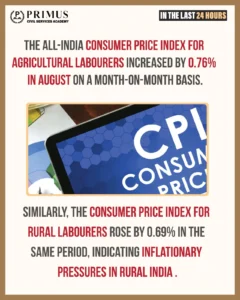
Relevance to UPSC
Paper 1: Related to Agriculture & Rural Livelihood
- Since agricultural labourers are rural dwellers, their inflation situation is linked with rural livelihoods, migration, agrarian distress etc.
Paper 3: Economy
- Inflation data is crucial for understanding macroeconomic stability, monetary policy, impact on rural economy, supply-side constraints, and food inflation. It influences decisions of the RBI, labour laws etc.
More about the News
- In August 2025, the All-India Consumer Price Index for Agricultural Labourers (base 2019=100) rose by about 0.76% month-on-month, reaching 136.34, while for Rural Labourers it rose by ~0.69%, to 136.60.
- Food and non-alcoholic beverages components increased more noticeably for Agricultural Labourers, the food index increased by ~1.39 points, indicating a food inflation pressure.
- However, year-on-year general inflation for Agricultural Labourers stood at ~1.07%, and for Rural Labourers ~1.26%; food inflation year-on-year for these groups was negative (slightly falling) in August.
Consumer Price Index (CPI)
The Consumer Price Index (CPI) is a statistical measure that examines the average change in prices paid by consumers for goods and services over time. It is a key indicator of inflation and cost of living, informing monetary policy, wage adjustments, and social welfare measures. Accurate CPI measurement is critical for economic planning, financial stability, and protecting vulnerable populations.
Background
- Introduced globally in the early 20th century as a tool to measure cost of living changes.
- In India, CPI was first compiled in 1947 by the Labour Bureau to monitor price changes for industrial workers.
- Currently, CPI data is compiled for Rural, Urban, and Combined categories and for specific groups like agricultural laborers (CPI-AL) and rural laborers (CPI-RL).
Evolution
- Early CPI focused on urban industrial workers (WPI used more for wholesale prices).
- 2011: CPI (Rural + Urban) introduced as the official measure for inflation by the Ministry of Statistics & Programme Implementation (MoSPI).
- Ongoing updates include base year revisions (latest 2019=100) and inclusion of digital consumption patterns.
Evolution
- Early 2000s: Conceptual studies on mirror peptides.
- 2010s: Successful synthesis of mirror RNA and proteins in vitro.
- 2020s: Recognition of biosecurity threats; calls for moratoriums and global oversight.
Key Data Sets
- All-India CPI for Agricultural Labourers (CPI-AL)
- Consumer Price Index for Rural Labourers (CPI-RL)
- Combined CPI (Urban + Rural) for general inflation measurement
- Monthly and year-on-year inflation trends (e.g., August 2025: CPI-AL rose 0.76% month-on-month, CPI-RL 0.69%).
Features of CPI
- Measures price changes for a representative basket of goods & services.
- Includes food, clothing, housing, transport, health, education.
- Reflects consumer cost of living rather than wholesale prices.
- Updated periodically for accuracy with changing consumption patterns.
- Used for policy, wage adjustments, and inflation targeting.
Uses of CPI
- Inflation monitoring for RBI monetary policy.
- Adjusting wages and pensions for cost of living changes.
- Social welfare planning (e.g., subsidies, MNREGA wages).
- Economic research and forecasting.
- Price indexation in contracts and taxation.
Advantages of CPI
- Monetary Policy Guidance: Helps RBI adjust repo/CRR rates to control inflation.
- Social Welfare Planning: Determines MGNREGA wages, PDS entitlements.
- Economic Benchmarking: Helps track purchasing power and cost-of-living trends.
- Indexation of Salaries and Pensions: Ensures real income protection; e.g., DA adjustments for central government employees.
- Transparent Policy Tool: Provides clear data for fiscal and subsidy decisions.
Disadvantages of CPI
- Urban Bias: Basket may overrepresent urban spending habits.
- Excludes Quality Changes: Fails to account for improved product quality over time.
- Regional Variations Ignored: May not reflect local price trends accurately.
- Lagging Indicator: Monthly CPI updates may not capture sudden price shocks.
- Data Collection Issues: Misreporting or delays can affect accuracy, e.g., informal market prices.
Impacts of Its Usage
- Policy Decisions: Inflation targeting by RBI using CPI trends.
- Wage Adjustments: DA revisions for government employees based on CPI.
- Subsidy Allocation: PDS and social security programs calibrated on CPI data.
- Investment Planning: CPI informs bond yields, inflation-indexed securities.
- Public Awareness: Citizens track inflation and cost of living for household budgeting.
Challenges Faced
- Changing Consumption Patterns: Digital goods and services not fully captured.
- Data Collection in Rural Areas: Logistical difficulties in remote areas.
- Informal Economy: Prices in unorganized sectors are often excluded.
- Regional Disparities: CPI may understate inflation in certain states.
- Time Lag: Data compilation delays reduce real-time usefulness.
Recommendations by Committees
Expert Group on CPI (2014, MoSPI):
- Update basket items periodically.
- Include more rural consumption patterns.
- Improve data collection methods using technology.
Government Measures:
- Revised base year to 2019=100.
- Regular monthly publication of CPI data by MoSPI.
- Integration of CPI in inflation targeting framework by RBI.
- Expansion of rural and occupational-specific indices like CPI-AL and CPI-RL.
Best Global Practices
- US: Bureau of Labor Statistics (BLS) regularly updates consumption basket and weights.
- EU: Harmonized Index of Consumer Prices (HICP) allows cross-country inflation comparison.
- Japan: Includes quality-adjusted price changes for durable goods.
- UK: Uses nationwide online and offline price collection for real-time accuracy.
Way Forward
- Incorporate digital and online consumption patterns.
- Improve real-time data collection via technology and big data.
- Expand regional and income-group-specific CPIs.
- Use CPI as a decision-support tool for targeted subsidies and monetary policy.
- Enhance public understanding and transparency of CPI methodology.
Types of Price Indexes
Type of Index | Features | Advantages | Disadvantages |
Consumer Price Index (CPI) | Measures retail prices for consumer goods & services | Reflects cost of living, guides policy | May not capture quality or regional variation |
Wholesale Price Index (WPI) | Measures price changes at wholesale/producer level | Tracks producer-level inflation | Doesn’t reflect consumer prices directly |
Producer Price Index (PPI) | Prices received by producers | Early inflation indicator | Excludes services, consumer-level impact |
GDP Deflator | Measures price changes of all goods/services in GDP | Comprehensive measure of economy-wide inflation | Less frequent, not useful for monthly adjustments |
Table of Key Items Included and Excluded in CPI
Category | Key Items Included | Key Items Excluded |
Food & Beverages | Rice, wheat, pulses, vegetables, fruits, milk, meat, eggs, sugar, edible oils, tea, coffee | Alcoholic beverages, tobacco (in some CPI variants), packaged snacks |
Housing | Rent for housing, fuel for cooking/heating, maintenance charges | Purchase of land or property, real estate investment |
Clothing & Footwear | Garments, shoes, sandals, traditional clothing | Luxury designer wear, imported footwear |
Fuel & Light | LPG, kerosene, electricity, firewood | Petrol, diesel (sometimes tracked separately in WPI) |
Transport & Communication | Public transport, bus fares, telephone, mobile charges, internet services | Personal vehicle purchase, insurance premiums |
Medical & Health | Medicines, doctor consultations, hospital charges | Cosmetic surgery, luxury health services |
Education | Tuition fees for school/college, books, stationery | Private coaching or overseas education fees |
Recreation & Culture | Newspapers, cinema, cultural activities | Luxury recreation, foreign travel |
Miscellaneous | Personal care items, domestic services, household goods | Luxury consumer goods, speculative investments |
CPI remains a cornerstone of economic planning and inflation management. Modernization, regional inclusivity, and digital integration will enhance its accuracy and policy relevance. Accurate CPI measurement ensures informed decision-making and protects citizens’ purchasing power in a rapidly evolving economy.
Prelims MCQ
Q. Consider the following statements about the Consumer Price Index (CPI) in India & select the correct answer:
1. CPI measures changes in the price of a basket of consumer goods and services.
2. CPI-AL is used for setting minimum support prices for crops.
3. CPI data is used by RBI for inflation targeting.
A. 1 and 2 only
B. 2 and 3 only
C. 1 and 3 only
D. 1, 2 and 3
CPI measures consumer goods and services prices and is used by RBI for inflation targeting. Statement 2 is incorrect; MSP is primarily determined by CACP and not CPI-AL.
Mains Question
Q. Critically examine the role of Consumer Price Index (CPI) in India’s economic policy framework. Discuss its advantages, limitations, and the steps needed to make CPI a more inclusive and real-time indicator of inflation.



